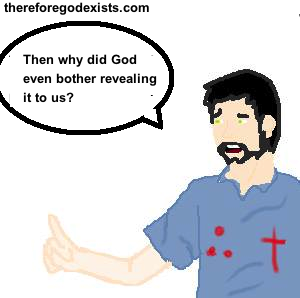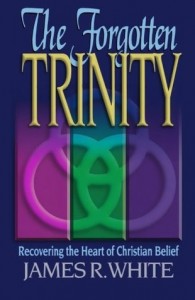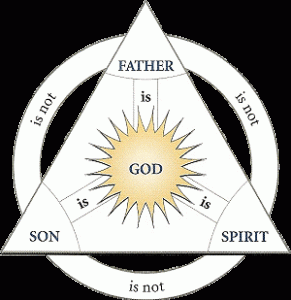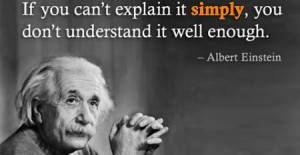 When we want to explain something, especially complex topics, we often want to appeal to analogies and illustrations as tools to help us illustrate our point. This seems to carry over into theology. Since the doctrine of the trinity is often built up as something so complicated that no mere mortal could ever understand any aspect of, we scramble desperately for a way to relay this divine truth to new Christians. But as we tell them how complicated it is, and how they just need to take it on faith, we are likely to lead our friends astray into confusion. So how can we relay this point? What is a good analogy for the trinity?
When we want to explain something, especially complex topics, we often want to appeal to analogies and illustrations as tools to help us illustrate our point. This seems to carry over into theology. Since the doctrine of the trinity is often built up as something so complicated that no mere mortal could ever understand any aspect of, we scramble desperately for a way to relay this divine truth to new Christians. But as we tell them how complicated it is, and how they just need to take it on faith, we are likely to lead our friends astray into confusion. So how can we relay this point? What is a good analogy for the trinity?
I think it should be pointed out that the trinity is not necessarily a mystery. It is not beyond all human comprehension. It may be counter-intuitive, but we can still grasp it. We can still understand what the Bible says. God may be more complicated than a man, or more complicated than what we expect, but we can still understand what the Bible teaches. The Bible teaches three truths: 1 – there is one God. 2 – The Father, the Son, and the Holy Spirit are each God. 3 – The Father, the Son, and the Holy Spirit are distinct persons. As John 1:18 says, Jesus is “the only begotten God, in the bosom of [God] the Father.” Therefore, there is one God, who is eternally present in three persons. How can we simplify this? How can we reduce it down? What is a good analogy for the trinity?
Is the trinity like H20, or a man who is a father, a husband, and a son? As we appeal to these elements of the world that people know and comprehend, we try to render the trinity relatable. We try to fit the trinity into the rational mans’ previously accepted paradigm. So we tell them, “Just as a man can be a father, a son, and a husband, so God is the Father, the Son, and the Holy Spirit.” But that comparison is fatal to the trinity.
A man who is a father, a son, and a husband is not three distinct persons. He does not have three centers of consciousness. These are just three modes that he takes. But God does not take on different modes. That is modalism. So the same with the H20 illustration. For us to draw these comparisons only muddies the water. In attempt to simplify, these comparisons complicate. 
Three in one comparisons. In response to hearing of the doctrine of the trinity, people may pose the question, “but how could God be both three and one?” That is a clear contradiction, so how could that be so? Obviously he is not both three gods and one god, and obviously he is not both three persons and one person. That would be a contradiction. Rather, God is one God, and three persons. God is eternally present in three persons: the Father, the Son, and the Holy Spirit.
The mind may still boggle at this notion, at the presentation of three in one. I think it may be permissible at this point out that there are other things in the universe that are three in one. A triangle is one triangle and three sides. That is not to say that a triangle and the trinity are identical, but for the purpose of illustrating that three in one is not always a paradox, the concept of a triangle is a useful tool. So a triangle may not be an analogy to the trinity, but an analogy to the coherence of three in one. Three in one is not an incoherent concept, and when a triangle is used that way, and that way only, it is not wrong.
Explain from Scripture. When people hear the doctrine of the trinity, they may be inclined to think that it is a consequence of contradictions opposing views of the authors, and we are trying to reconcile them. That is why it is important to show verses such as John 1:1-2. “In the beginning was the Word, the Word was with God, and the Word was God. He was with God in the beginning.” The Word was both God, and with God. John empowers this point toward the end of his prologue as he calls Jesus (v. 18) “…the only begotten God, in the bosom of the Father…” So we see two distinct persons within the one God.
Another good proof-text would be Isaiah 44:6 (and I went into more detail in my article 3 Reasons Atheists Are Afraid To Read Isaiah) which reads, “So said the Lord, the King of Israel and his Redeemer the Lord of Hosts.” Both times the word Lord are used, they replace the word YHWH, the name of God. So in this verse, there are two who are called YHWH: the Redeemer and the King of Israel. Yet a few verses down, Isaiah plainly states that there is only one God (44:8). The testimony of Scripture is that there is one God who is eternally present in three persons. What is a good analogy for the trinity? Do not worry about analogies. Look to Scripture. 
Stop overcomplicating everything. It seems like every time I hear a Christian explaining the doctrine of the trinity, they preface it with a few qualifications about how the trinity can only be understood by faith and that it is beyond all human comprehension and they will never understand it. I think that it is within human capacity to understand what the Bible reveals, or else there would not be any reason for the Bible to reveal it.
If you think it is too complicated to understand, then perhaps you should not be teaching people. Physician, heal yourself. Learn what the trinity is, because there is a succinct and simple definition that is easy to understand. It may be counter-intuitive. It may seem like an illogical model of God (although I argued against this in my article Is The Trinity A Logical Model of God?), but it is not so complicated that no human being can understand it. It is only like that because you are the one explaining it and you are overcomplicating it.
What is a good analogy for the trinity? A worm looks up at a man. We would not expect the worm to instantly understand the man, or the man to be precisely what the worm expects. Yet we look to the heavens and hold expectations of God. God may not be what you expect. There may be no analogy of the trinity that does not break down at some point. But that does not mean that you cannot explain what the Bible reveals. Stop desperately shuffling through fallacious analogies. There is one God who is eternally present in three persons. That is the trinity.
If you would like to get in on the discussion about this, join my Theology Discussion Group!